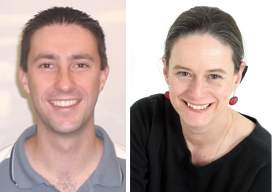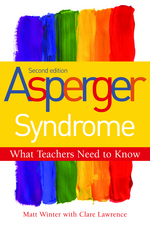 Matt Winter began his career as a teacher and private tutor where he gained extensive experience working with children with Asperger Syndrome (AS) and conducted significant research into supportive intervention techniques. Matt is also actively involved in charity work focused on youth development, support and education. He resides in Wellington, New Zealand.
Matt Winter began his career as a teacher and private tutor where he gained extensive experience working with children with Asperger Syndrome (AS) and conducted significant research into supportive intervention techniques. Matt is also actively involved in charity work focused on youth development, support and education. He resides in Wellington, New Zealand.
Clare Lawrence is a teacher, autism worker and mother of two children, one of whom has AS. She works closely with schools across the UK, exploring practical solutions for how to make education more accessible for children with AS. Clare lives in Peterborough, UK.
Here, Matt and Clare answer some questions about the new edition of Asperger Syndrome – What Teachers Need to Know, the perfect go-to guide for teachers, teaching assistants and those in school management who want to know more about Asperger Syndrome in the mainstream inclusive classroom.
 How did you come to work with children on the autism spectrum, and how did these experiences inspire the book?
How did you come to work with children on the autism spectrum, and how did these experiences inspire the book?
Matt: My first experience working with a child with AS was when I was completing my training as a Primary School teacher. One of the classes that I was a student in had a child with AS. It struck me right back then how little most teachers knew about the syndrome. However, my work in the field didn’t begin in earnest until I was lucky enough to begin a role as a private tutor to a boy with AS whose father and brother also happen to have it. It was in this role that I was given time to research AS, work with the Cloud 9 Children’s Foundation supporting families that have children with AS, and apply everything I learnt into the practical world. Through this process I just could not believe how much information I had to read through to gain useful approaches for working with children in the education setting. I just knew that during my time as a classroom teacher I would never have had the luxury of completing this much reading for just one of my students and I became determined to distil down what I had learnt into a quick access guide for teachers.
Clare: I am a secondary school English teacher, but I didn’t know a great deal about the autism spectrum until our son was diagnosed in 2003. Since then I have spent a great deal of time going on course, gaining qualifications, visiting various school and talking to teachers, TAs, pupils and parents. It has all been absolutely fascinating and I feel very lucky in the direction my life has taken!
What is new about this second edition? How did it come together?
Matt: Thankfully AS has gained prominence over time and in the period since I first wrote the book more has been learnt about how best to work with a child with AS. Although the book still covered the vast majority of what a teacher needed to know, there was now more to be added – particularly in the context of older children. Since I first wrote the book I have moved out of the education sector and therefore it was appropriate to bring Clare on board for the revision.
Clare: ASD is an exciting area as, because it is still a relatively ‘new’ field, there are constant changes and innovations. I was very pleased to work on the project as the first edition was such a tremendously positive and useful book.
What are some of the most common things teachers feel insecure about when it comes to teaching and interacting with Aspergers students? How can the book empower them?
Matt: Teachers are true heroes in our society. They work incredibly hard to meet the needs of their students, often with restricted resources. They are under enormous time pressure to deliver an educational programme to their children who are not on the autistic spectrum. I believe the most daunting aspect when a child with AS joins their class is just knowing where to begin and finding the time to learn about their needs and how best to meet them. The concise nature of this book will allow them to overcome this in minimal time. Sections are often constructed with bullet points to allow quick access to information. The content is to the point and practical. It gives an insight to the condition but focuses on action. Even better – most of the things that you can do to help the child with AS are also beneficial to the class as a whole!
Clare: I think many teachers don’t feel particularly confident about being able to meet the needs of children with As in their classes. Each child with AS will present very differently and teachers can be confused about how best to work with difficulties and encourage strengths and generally be able to bring out the best in these children.
What piece of advice in the book will ‘save a teacher’s life’ in the classroom?
Matt: In the section that deals with the common feeling that teachers have of inadequacy, I remind them that they all have an expert in AS in their class – the child themselves. I remember in my first year as a classroom teacher I was looking after a colleague’s class for an afternoon and there was a boy in there that had AS. I really wanted to change what was planned for the afternoon but I had been given warning that he did not cope with change well. I thought I might just test the water by running through the change with him. I started to explain in a round-about way what I wanted to do when he cut me off and said: “You are changing the plan but I need to finish this. Leave me alone and when I am done I will come and join you all on the mat.” Great – and that is exactly what we did!
Clare: Keep your sense of humour! Although it is, of course, very serious when a pupil with AS is struggling, the subject needn’t be all gloom and doom. Pupils with AS can be brilliant to have in your class – funny, original, quirky, honest, tenacious and single-minded. Be confident and enjoy the experience!
What difference can a primer like this book make for students and for teachers?
Matt: Although I hope the book will inspire teachers to read more on the syndrome (particularly in order to gain a better awareness of the child’s perspective), I am a realist and know that for many this is as far as they will go. The great thing is that if this is all that a teacher reads on the topic, they will have accessed a huge amount of the practical information available. They will be able to remove large amounts of stress from child’s life and in turn their own. Even better, the whole class will benefit through the additional structure and clarity that the techniques provide.
Clare: The book is a quick-reference, giving instantly accessible information and ideas. It is very much a starting point; I hope that teachers will catch the ‘autism bug’ and go on to find out more and more about this fascinating condition. However, for the busy teacher faced with a child in their class TODAY the book is a practical, hands on and positive source of advice and ideas. I hope teachers will enjoy using it and enjoy the experience of teaching the pupil with AS.
Copyright © Jessica Kingsley Publishers 2011.